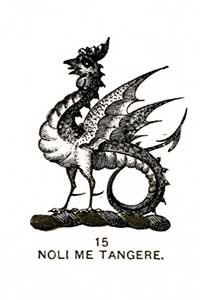The Prendergast Family

(Crest No. 15. Plate 69.)
THE Prendergast family is of Norman origin. When Richard de Clare, commonly called Strongbow, led the first Norman invaders to Ireland in 1169, his army was headed by Robert Fitzstephen, Myler Fitzhenry, Maurice Prendergast, and others. The Prendergasts obtained lands and settled in the present Counties of Cork, Clare, Limerick, and Waterford.
The Prendergasts were for many centuries following the invasion powerful chiefs, and many of them were noted for their prowess in battle. The seal of one of these chiefs, David Prendergast, who lived in the middle of the thirteenth century, still exists, as appears from an impression of it in the museum of the late Dr. Petrie, of Dublin. It bears his arms on a shield, and the legend is S. David de Prendergast.
The Rev. Patrick Prendergast, who was known as “The Lord Abbot,” was the last abbot of the abbey of Cong, where he died and was interred in 1829, at the advanced age of eighty-eight. He kept for years in a cupboard in his little room the famous Cross of Cong, the richly-decorated shrine, said to contain a tooth of St. Patrick, which the Saint on the occasion of one of his visitations to Northern Connaught gave to Bishop Bronius when he founded the Church of Cassel-Irra, and a piece of stained linen said to have been dipped in the blood of Charles the First after his execution at Whitehall. This relic was supposed to possess the power of curing the king’s evil, and hundreds of afflicted persons came to be touched with it. This is said to be the last instance when this curious rite was exercised in the British Isles.
Among the best known of this family in latter times is the late John P. Prendergast, the Irish historian, author of “The Cromwellian Settlement of Ireland” and other valuable works.
